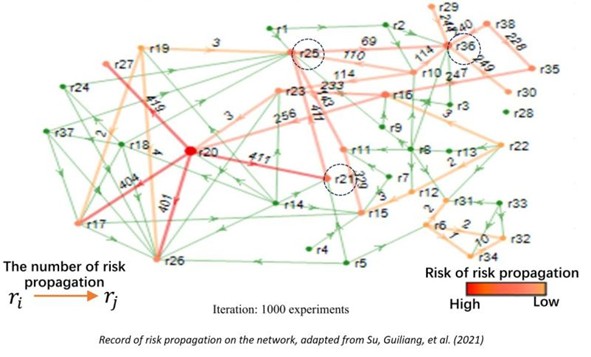From reliance to resilience: How Canada can accelerate nation-building projects through proactive risk management

A core mission of Canada’s new government is to accelerate the delivery of major national projects. The recently announced federal budget outlines $115.2 billion in infrastructure investments over the next five years [1]. This includes fast-tracking nation-building initiatives across sectors such as trade and transportation, public infrastructure—including roads, bridges, water systems, and public transit—and other critical areas. It’s a generational investment aimed at protecting and transforming industries, strengthening the economy, and empowering Canadians.

Figure 1: Upcoming Federal Expenditure on Infrastructure – 5-Year Horizon (billions of dollars, accrual), Budget 2025 - Canada Strong
However, research indicates that fast-tracking these large, complex, and interdependent projects poses significant challenges, especially in today’s increasingly uncertain world. As part of risk treatment strategy, the government has recently launched the Major Projects Office (MPO) to streamline federal review and approval processes and boost confidence in successful project execution. This proactive risk mitigation approach is expected to reduce the impact of permitting and approval risks, which often rank among the top exposures in the risk registers of most nation-building projects. However, despite this mitigation measure, many risks continue to threaten the successful planning and execution of these initiatives. The following sections will present data-driven insights on Canada’s skilled labour shortage and outline innovative solutions to close this critical gap.
Systemic Risk-Based Thinking: Understanding the Dynamic Nature of Projects and Risk Interdependencies
From a systems perspective, projects have dynamic behavior, with multiple risks that often interact and depend on one another. Success in any project largely hinges on understanding risk interdependencies within the broader project risk network, where one risk can trigger or amplify others. In such cases, mitigating a single risk may not effectively reduce the overall risk profile.
For example, the figure below illustrates a visualization of risk interdependency modeling in a sample IPD project, based on a study conducted by Tsinghua University [3]. From a systemic perspective, addressing risks at an individual level (e.g., r20) without considering its influence on other interconnected risks (r17, r21, r23, r27, r26) within the overall risk network may not be effective and could fail to reduce the project’s overall risk profile. To meaningfully lower overall project risk exposure, mitigation strategies should be applied at the network level rather than targeting individual risks in isolation.

Figure 2: Risk intendency network Su, Guiliang, et al. (2021)
At the moment, one of the key risks threatening the successful delivery of infrastructure projects in Canada is the shortage of skilled labour in the construction industry. A parent risk (a broad, high-level risk that can cause, more specific "child" risks), interconnected with many other child risks. Thus, in the remainder of this blog, we’ll focus on an evidence-based study of labour shortages in Canada’s construction sector and propose mitigation actions informed by the literature.
Skilled Labour Shortage in the Canadian Construction Industry
Labour shortages in the construction sector are structural. As shown in the figure below, a recent academic study conducted jointly by the University of British Columbia and the University of Calgary projects a deficit of over 30,000 workers by 2027—serving as an early warning that Canada may face a significant labour shortage unless the construction industry takes proactive measures [4]. As outlined in the report, labour demand in the construction sector is expected to grow by roughly 18,700 workers by 2027. During this period, an estimated 156,000 individuals are anticipated to retire. Even with current recruitment trends potentially bringing in around 142,800 new workers, the industry is still expected to fall short by approximately 31,800 workers.
There is concern that the reported deficit may reflect an optimistic scenario, given the assumption of successful recruitment across all required roles and no expansion in infrastructure pipelines. The two assumptions that both appear to be at risk considering recent government announcements aimed at fast-tracking major national projects, coupled with the impact geopolitical risks.
So, what is the path forward and how can the construction industry in collaboration with government align their efforts to tackle this multifaceted challenge, shaped by a complex interrelated factor?

Figure 3: Expected fluctuations in the Canadian construction workforce, Kumarage, Nipun, et al. (2024)
Delivering More with Less: Boosting Productivity to Address Skilled Labour Shortage
At Hatch, we believe that by collaborating with our partners and clients, we can drive positive changes in the industry, enabling us to do more with less easing the pressure of labour shortage. While there are many potential solutions for tackling skilled labour shortages in Canada, our ongoing conversations with clients consistently point to one approach as the most effective and efficient: boosting labour productivity to compensate for the natural decline in resource availability.
Labour productivity is often the greatest risk factor and a major source of cost and schedule uncertainty for both owners and contractors. According to research conducted by CII, the average productivity of craft labour in Canada, across most trades, hovers around 50% at best. This aligns with AACE 22R-01, where an analysis of 10,003 observations using Work Sampling technique during construction phase revealed that only 49% of labour hours were productive doing hands-on activities, while the remaining 51% involved nonproductive tasks and downtime activities [5]. Figure 4 illustrates the contribution of each category, highlighting areas that require improvement.
Reducing the ratio of nonproductive to productive hours is a fundamental step toward addressing labour shortages and ensuring the successful delivery of Nation-Building projects. This should be considered a critical risk mitigation strategy and a primary area of focus for both government and the broader industry.

Figure 4: Example chart of labour hour utilization by work category with actual observed percentage as might be used for a daily report (AACE 22R-01)
The following is a list of the recommended actions to boost productivity in construction industry. Together we dive into these areas in the upcoming blogs.
- Modularization and pre-assembly strategies to reduce the required head counts on our sites
- Digital project delivery, including 4D construction simulation, advanced materials management and logistics
- Task automation and optimization (QA/QC, Health and Safety, construction progress measurement).
- Refine procurement frameworks to reward delivery models that integrate global expertise while maintaining local control.
What’s Next: The Labour Series
The Labour Series will share insights into innovative, data-driven approaches to boost labour productivity, reduce cost and schedule variability, and improve predictability. Hatch’s subject matter experts will explore project delivery best practices designed to enhance productivity and enable more cost-efficient outcomes.
References:
[1] Budget 2025 - Canada Strong
[2] COVID-19 in Canada: Modelling update - Canada.ca
[4] Strategies to alleviate Canada’s impending construction labour shortage: a critical review
About the authors

Randy McMeekin
Global Managing Director, Transit
Randy has more than 30 years’ experience at Hatch, with a career that has been centered around engineering, major projects, technology, and digital project delivery.
A mechanical engineer with an Honors B.Sc. from Queen’s University in Ontario, Canada, Randy is a passionate leader. He demands excellence, but never lets that compromise his caring for people and teams. His client-centric thinking and steadily increasing experience and responsibilities have made him the right person to lead engineering at Hatch and achieve our goals of technical excellence and industry-leading, differentiated engineering skills.
Randy has recognized expertise in digital project delivery, engineering management, and project leadership. He also has significant experience leading construction and commissioning teams, with a strong record of fostering sustainable safety cultures on our clients’ sites. He has successfully delivered numerous capital projects on time and on budget, across a wide range of sectors, and is well respected by our major clients.
.jpg?h=200&iar=0&w=180)
Lise Bouchard
Managing Director, Project Management and Construction Excellence
Lise is an engineer with over 25 years of experience in management and project controls with most in project execution phase of multi-billion projects in mining, metals and infrastructure. Having worked oversees for over 15 years in different project phases and execution strategies including within a joint-venture environment, Lise brings that expertise to her role, keeping Hatch at the leading edge of technical and delivery excellence.

Jordan Matte
Global Director, Government Relations
Jordan leads Hatch's government relations work globally, bringing extensive experience from both local and international arenas, most recently as senior advisor for natural resources in the Office of the Premier of Québec. Jordan helps Hatch navigate a shifting geopolitical landscape and complex policy environments. taking a lead role in Hatch’s pursuit of government-sponsored projects, developing long term relationships with government partners globally, and helping us take better advantage of government services, such as trade commissions and granting agencies. Prior to his work in government, Jordan was a vice president at Teneo, a global strategy consulting firm. He previously served as economic policy advisor to Canada’s Leader of the Official Opposition.

Moe Roghabadi
Global Director, Risk Solutions
Moe Roghabadi is Global Director, Risk Solutions at Hatch, leading the development of best-in-class risk management capabilities. With over 15 years of research and field experience, he enables informed decision-making for large-scale projects across infrastructure, mining, and energy. His expertise spans delivery models including P3, EPCM, Alliance, and Progressive Design-Build. Moe holds a Ph.D. in Construction Engineering and Management and serves as Vice President of AACE Toronto and an affiliated member of CICIEM at Concordia University.